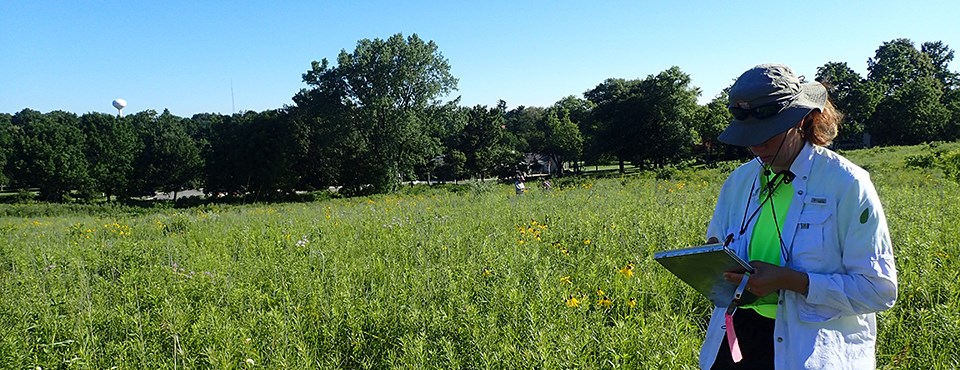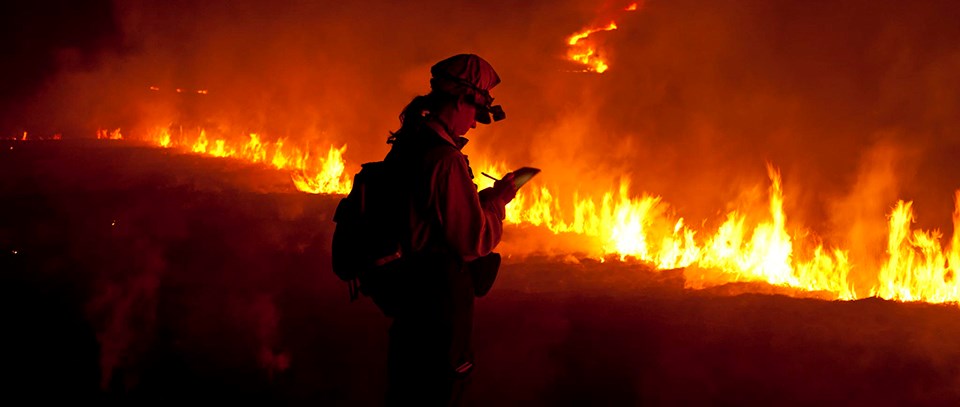Last updated: February 28, 2022
Article
Women in Fire Science: Sherry Leis

NPS
Fitting in with Fire
I didn’t know I was headed for a career in fire until I was steeped in it. I had participated in a prescribed fire at my college’s little prairie; then as a Peace Corps volunteer I worked with villagers to create fire breaks and protect their forest in The Gambia. Later on, I worked as a prairie restoration intern with the Aldo Leopold Foundation. My next foray into fire during graduate school would seal the deal. I’ve worked in positions that focused on fire ever since, first as a grassland botanist, now as a plant and fire ecologist.
I currently serve as the Heartland Inventory and Monitoring Network’s plant and fire ecologist. For nine years, I exclusively ran the fire ecology program for seven parks in the Midwest as a partner to the National Park Service. In 2016, I was fortunate to be hired into the National Park Service. In my work, I try to blend the understanding of plant communities with the effects of fire to provide managers with information with which to make sound decisions. I often take an interdisciplinary approach to my work. This kind of approach can be challenging, but our local work team is embracing it more often as a way of doing business.
I love prairies, and fire is a necessary part of maintaining them. Working with the Aldo Leopold Foundation in Wisconsin, where I grew up, was a pivotal experience in my career. I was steeped in the legacy of Leopold as I worked on prairie restoration and burning in the places he himself trod. Because of my love of prairies, I eventually went to graduate school in Oklahoma and studied disturbance in the mixed grass prairie. I was the first woman to complete Oklahoma State University’s advanced fire ecology course and only one of two women in the rangeland ecology and management department. I sometimes had to insert myself in to the graduate student’s office to be part of the group. Since that time, I’ve continued to work on grassland projects involving fire in professional positions. I have led teams like the patch burn grazing learning network and the Great Plains Fire Science Exchange.

Julie Denesha; used with permission.
Often in my career, I’ve worked on the fringes. I am in the minority that work in fire and grasslands. There are few women with rangeland background in the central United States. Although I participate in prescribed fire operations, I don’t carry the heavy load of wildfire work. Not going on the big fires can make it harder to get credibility in the fire world. Being the science nerd on the fire, can make it tough to relate to the operations folks until you’ve been around for a while. At the heart of what I do, is still the love of prairies. I just taught 138 junior high school students that grasslands are an incredibly important resource. Much is lost every time prairie is plowed or paved under. The words of Aldo Leopold echo frequently to me. He knew that land management was really about managing people. In order to take care of our natural resources, we have to learn about the things that are important to each other and the public. We have to manage our relationships along with the land. When you mix understanding of people with natural resource science, you can get interesting results. In my work, I try to understand how management, particularly prescribed fire, contributes to achieving management goals.
The National Park Service is unique in its commitment to natural resource science. We have an incredible opportunity to work with managers using data and expertise that many other agencies don’t have. It is exciting to contribute to the conservation of some of the coolest places on earth as a scientist.
Every summer I teach a fire ecology workshop for high school students as part of the Green Academy for Diverse Ecosystems in southern Missouri. Girls in the class often aren’t aware that working in fire was even an option. I’ve also tried to relate to the boys in the class, that they can be supportive of their female coworkers when it is their time to join the work force. With all of the news about misconduct within fire and other fields, young women may be discouraged from joining those fields where they will be a minority. I hope the opposite happens - that women flock to those fields and demand to be treated fairly so that equality and respect will be the only options going forward.
My advice to young women joining the fire fields is that they should avoid trying to fit in by developing their own machismo. I’ve found that things work best when you are simply yourself. Wear a pink helmet if you must, but the best way to fit in is to do your job well. Figure out what your strengths are and how to use them as assets for your team. Those are the things that gain you respect and acceptance.
Tags
- herbert hoover national historic site
- tallgrass prairie national preserve
- wilson's creek national battlefield
- fire science
- international day of women and girls in science
- heartland inventory and monitoring network
- fire ecology
- fire careers
- fire jobs
- women in science
- science
- meet the scientist
- nps careers
- htln
- women of the nps
- in the field
- featured
- interns artists volunteers
- women in fire science
- midwest
- iowa
- kansas
- missouri
- inventory and monitoring division
- wildland fire
